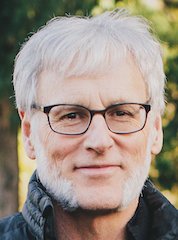“My life is a listening. His is a speaking. My salvation is to hear and respond.”
Challenge Nine: Leaders Fail to Prioritize Spiritual Discernment in Their Decision-making
You can hardly grow in life, let alone plant a church, without learning to listen well.
As Thomas Merton put it, “My life is a listening. His is a speaking. My salvation is to hear and respond." The capacity to listen deeply begins in the arena of our own personal journeys, and it expands outward from there.
Listening is of course foundational to the practice of good judgement, or what we call “discernment." Dr. Leonard Sweet asserts that “the initial mode of leadership is receptivity: hearing, not speaking. A hearing heart picks up signals rather in the way radio receivers pick up waves from the ether. In fact, sometimes you ‘hear’ it from its absence as much as from its presence…” Sweet argues that “we naturally prefer the eyes to the ears because when we look with our eyes we are in control of reality…When we hear with our ears, we are vulnerable to reality…With the eyes we can construct our own reality; with the ears we have to deal with situations as they really are…” (1).
In our vision development and in our decision-making, we as church starters need to take Sweet’s words to heart. It’s easier to see ahead than it is to hear––in surround-sound––what is going on all around us at any given moment. In the face of rising complexities in our culture we need to learn this art of stereophonic listening, which involves the capacity to simultaneously tune in on three levels so that we might discern:
What the Spirit may be saying to us directly and from the Scripture narrative.
What we as a team (and forming core) sense is “right and good” to do.
What the soundings of our local context have to tell us.
As we face complex and sensitive leadership decisions, I believe these three modes of hearing can help us lead much more wisely and with greater satisfaction and Kingdom impact. Let’s consider what it might mean to activate these three modes of listening within our own team.
Listening to God or God-echoes
If we’re honest, too often we call God into the picture only to rubber-stamp what we’ve already decided.
True spiritual discernment will always make provision for the Spirit to offer input and to even overturn what may appear to be a brilliant plan of action.
Of course, that guiding voice can be heard in the soil of the sacred text, where we “in simple humility, let our gardener, God, landscape us with the Word, making a salvation-garden of our lives” (James 1:19, The Message).
If we approach our leadership decision-making as an act of worship and stewardship, we may be more inclined to exercise the patience and pace to tune into those Holy Spirit hunches. Hopefully, we will also incorporate input from those who are prophetically gifted, as oftentimes God will speak through them by means of images, dreams, impressions, etc. This little essay on accessing the prophetic to enhance our hearing capacity may be worth reading. For complex decisions, I encourage every team to also tap into one or more trusted mentors and at least one experienced leadership coach (preferably with church planting experience), as there’s both safety in this counsel and reservoirs of wisdom. And while we’re at it, we all can benefit greatly from ongoing spiritual direction, as the rhythm of meeting with a director helps train our ears to pick up frequencies we often miss.
Listening to Our Body
“It seemed good to the Holy Spirit and to us...” (Acts 15:28).
As part of my wife’s spiritual direction training with the Franciscans, she is learning to practice “somatic mindfulness,” a focusing technique that enables one to carefully tune into what their physical body may be telling them at any given moment. This practice includes mindfully visiting and exploring each part of the body in order to tune into those areas where we’re holding stress or tension. When tightness or an ache is noticed, the mind is guided to gently help the body receive comfort, release or healing in that particular spot.
Our church startup team would do well to honestly assess our own practice of somatic mindfulness, only the soma (body) I’m talking about is actually our little Christocentric initiative.
How do we as leaders truly hear each other’s hearts/perspectives? What does that look like in practice? And what do we do to ensure that others in our community are able to provide valuable feedback on issues of direct concern to them as stakeholders? What guidelines have we laid out to help the wisdom within our midst flow into the thinking/weighing of our leaders?
Perhaps one of the most effective ways for us as leaders to grow in our capacity to pay attention to our forming body is to pull ourselves together into little listening dyads or triads. Spiritual friendship can be a fertile field for us to learn not only how to discern what’s in our own heart, but also to hear what is ringing out from the hearts of others covenanted with us as co-listeners.
If you’ve never practiced spiritual friendship in any formal sense, here’s a practical essay on how to go about it.
What leaders regularly practice together to discern their own lives and what God/wisdom may be offering becomes foundational to a faith community’s collective discernment.
Listening to Context
With the rising heterogeneity of American culture, church starters need to learn to operate with cross-cultural listening skills that missionaries (not colonialists!) utilize to become cultural insiders.
In my experience, people crossing cultural boundaries with the aim of cultivating God’s shalom will generally need to engage in three primary movements or behaviors:
1) immersing and listening (ABSORBING);
2) connecting and befriending (RELATING); and
3) participating and enriching (SERVING).
These behaviors all involve an overlapping interplay (i.e. they’re non-sequential) as a team encounters its local setting. They also incorporate ongoing discernment as their practice yields all kinds of cultural data, relationships, and inroads for serving our local community.
If we can envision these ABSORBING, RELATING, and SERVING movements each taking a spot at a point on a Celtic trinity knot, we can “get the picture." The overlapping dynamic of the behaviors is captured by the lines that cycle back and forth to each corner (behavior) on the triangle, and all lines go through the center (which signifies our discernment filter with God and with our team/community). In other words, as missioners we discern wise/strategic responses as we absorb the soundings of context, as we relate to neighbors and other locals, and as we serve in various justice and compassion initiatives (2).
Of course, it’s not easy to hold the line in this kind of three-fold listening.
Urgencies from building and maintaining startup momentum scream at us to simply choose courses of action that make strategic sense, yield results quickly, or satisfy those we perceive as important stakeholders. (All of these, by the way, may have their place in a given critical decision-making moment). We may have to consider it a spiritual discipline to slow down the pace of our decisions on sensitive matters so that we can truly exercise “tact."
According to Merriam Webster’s, tact is defined as “a sense of what to do or say in order to maintain good relations with others, or to avoid offense. [It] implies delicate and considerate perception of what is appropriate” (3).
If we hope to be tactful in our leadership, we must put into practice a decent discernment process (4). Getting started may be as simple as defining a practice or two for each aspect of the UP-IN-OUT movements described above. Whatever measures we can take to grow as listeners will inevitably make us that much stronger and wiser in our leadership.
Some closing questions and suggestions:
What’s your criteria for discerning something? What does that package look like? What kind of decisions require keener discernment; which ones would you see as pretty straightforward and not needing broader consideration? How might we as a leadership team articulate, as clearly as possible, how we practice discernment on important decisions, so that we can turn to a tried and tested pattern time and again?
Alan Hirsch encourages a decision-making process called “six thinking hats,” which allows teams to factor in a multi-angled perspective on important decisions. SeeThe Shaping of Things to Come, by Alan Hirsch & Michael Frost (Grand Rapids, MI: Baker, 2013), 244-245. This sort of practice can also be modified into APEST questioning within a lead team, using the Eph. 4:11 orientations Hirsch describes in his book, 5Q.
Lastly, we can learn a lot from the anabaptist tradition as far as what it means to practice discernment well. The “leadership table” at Portland Mennonite Church discerned a “statement on sexuality,” which I think reflects leadership discernment at its best. They humbly worked together to craft a unified approach forward even though the leadership team was not in full agreement theologically. Check it out here.
Notes:
1. Summoned to Lead, by Leonard Sweet (Grand Rapids, MI: Zondervan, 2004), 57-60.
2. I’ve actually written a pithy, easy to read booklet for starters and churches on how to wisely (discerningly) sow God’s shalom in our local setting: Growing Local Missionaries: Equipping Churches to Sow Shalom in Their Own Cultural Backyard (Portland, OR: Urban Loft, 2014). Available on Amazon.
3. https://www.merriam-webster.com/dictionary/tact, accessed Oct 31, 2019.
4. Let me state clearly that I’m not suggesting we are either discerning or we’re not, but that too many of us (me included) regularly make poor leadership calls either because we’re too impatient, too restricted in our range of decision-making inputs, or too afraid that our preferred outcomes might be displaced if we let other strong/wise leaders weigh in (including both guidance and push-back from our primary Leader).
written by Dan Steigerwald
Photo by Steve Halama on Unsplash
For more about Dan or to get in touch with him, visit: https://artesiaresourcing.com/about/


